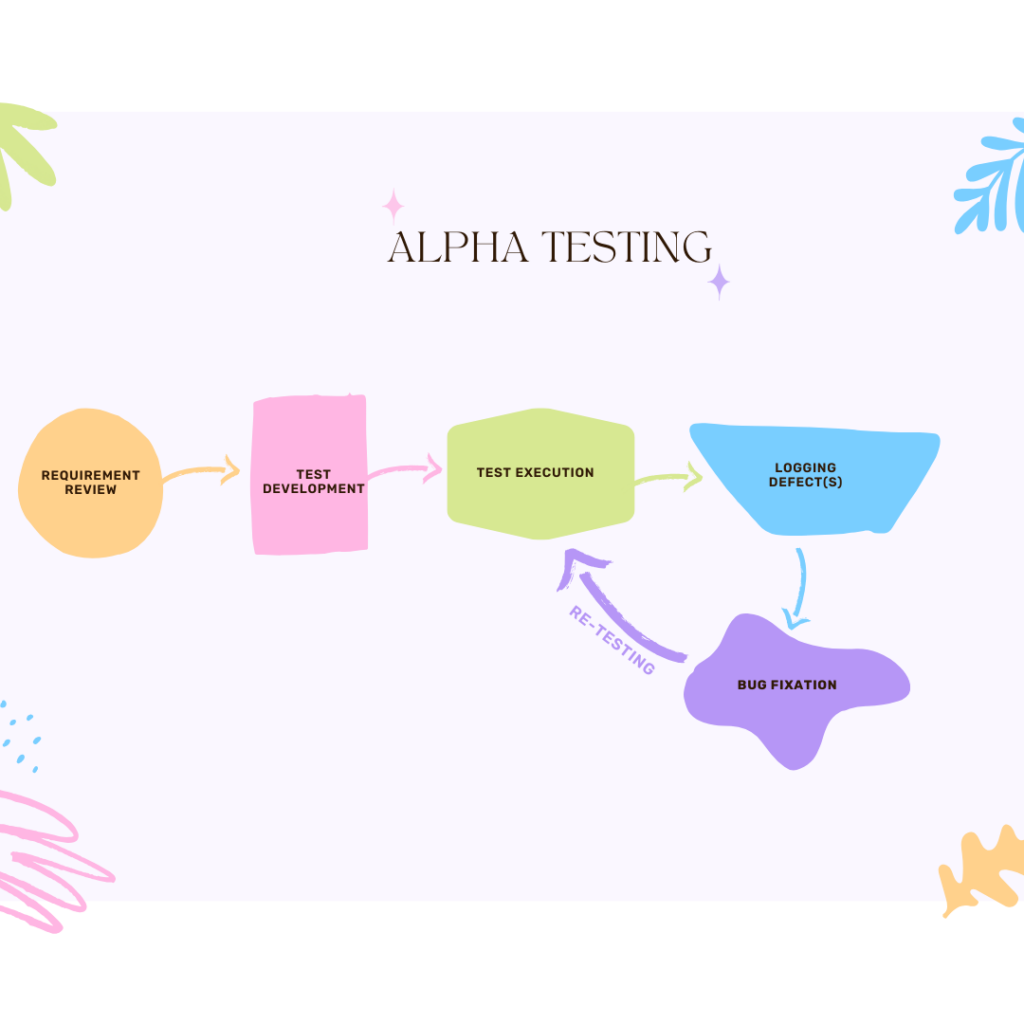Alpha Testing is a type of software testing performed to identify bugs before releasing the product to real users or to the public. This is one of the user acceptance testing. This is referred to as alpha testing only because it is done early on, near the end of the development of the software. It is commonly performed by in-house software engineers or quality assurance staff. It is the last testing stage before the software is released into the real world.
Alpha testing is a stage that takes place early in the development process, typically after the code has been written and before the final product is released to the public. It is performed by a select group of internal stakeholders, such as developers, testers, and members of the product team.
The purpose of alpha testing is to identify and resolve critical bugs and issues in the software before it is released to the public. It is performed in a controlled environment, such as a lab or a test network, and is used to simulate real-world use cases and identify any potential problems.
During alpha testing, the software is evaluated against a set of predetermined acceptance criteria and is tested for functionality, usability, performance, and stability. It provides an opportunity to identify and fix bugs and issues before they reach end-users, ensuring that the final product is of high quality and meets the needs of the target audience.
Objective
- Refining the software product: Alpha Testing identifies and resolves bugs not discovered during previous tests, enhancing the software’s overall quality.
- Involving customers early: Alpha Testing engages customers in the development process, ensuring their needs are considered throughout.
- Evaluating reliability: Alpha Testing assesses the software’s reliability in the early stages, promoting confidence in its performance.
- Identifying critical issues: Alpha Testing aims to detect and fix significant bugs before public release, ensuring the software functions as intended and meets user expectations.
By addressing these objectives, Alpha Testing contributes to the development of high-quality software that caters to the target audience’s needs and reduces the risk of post-release issues affecting end-users.
Process
- Review the design specification and functional requirements.
- Develop comprehensive test cases and test plans.
- Execute test plan
- Log defects
- Retest once the issues have been fixed

Phases
Alpha Testing involves two primary phases:
- First Phase: Conducted by in-house developers or software engineers, this phase uses hardware-aided debuggers or debugger software to identify bugs quickly. During this stage, testers often encounter various bugs, crashes, missing features, and documentation issues.
- Second Phase: Performed by software quality assurance staff, this phase comprises additional testing in a controlled environment, incorporating both black box and white box testing techniques.
The typical phases of alpha testing include:
- Planning: Defining the scope, objectives, and schedule for alpha testing while identifying the target audience, test environment, and necessary resources.
- Preparation: Setting up the test environment, configuring test cases, and preparing test data, as well as creating test scripts and building the test infrastructure.
- Execution: Running test cases, collecting results, reporting bugs, and having the development team work on fixing issues.
- Evaluation: Analyzing test results, determining whether software meets requirements and performs as expected, identifying areas for improvement, and recommending further testing.
- Reporting: Documenting test results, providing reports to the development team and stakeholders, and presenting findings with recommendations for future testing and development.
- Closure: Wrapping up the testing process, releasing the software for further testing or end-user release.
Benefit
- Early bug detection: Alpha testing identifies and addresses issues that might go unnoticed during development, reducing the likelihood of end-users encountering these problems in the production environment.
- Improved quality: Alpha testing ensures that software meets high-quality standards and requirements before its release to end-users.
- Cost-effectiveness: By identifying and resolving issues early in the development process, alpha testing ultimately saves time and money.
- User feedback: Valuable user insights from alpha testing allow the development team to make improvements and enhance the overall user experience.
- Increased confidence: Successful alpha testing provides assurance that the software is ready for beta testing and eventual release to end-users.
- Stress testing support: Alpha testing helps determine the software’s performance limits and ability to handle heavy loads, ensuring optimal performance in real-world scenarios.
Disadvantages
- Longer test execution for large projects: Larger projects require more time for thorough test plan execution.
- Unknown defects: During alpha testing, certain product defects might remain undiscovered.
- Difficulty in testing the entire product: As the product is still under development, it can be challenging to perform comprehensive testing.
- Time constraints for smaller projects: For smaller projects, the time spent on alpha testing may not be justified.
- Limited reliability and security testing: Alpha testing does not cover reliability and security aspects in depth.
- Shallow testing: The project team focuses on client-specified business requirements and may not thoroughly test each module.
- Dedicated testing environment: Alpha testing requires a separate lab environment, adding to the logistical and resource demands.
Find more in our blog.

